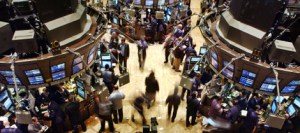


Core consumer inflation climbs at a 2.3% annual rate in July numbers
Granted the Federal Reserve watches the Personal Consumption Expenditures Index to measure inflation, but the big jump in the July Consumer Price Index should remove the last doubts (if any remain) about a September interest rate increase from the Fed. The headline...
Day ahead of Fed rate decision, inflation comes ion track for September interest rate increase
The Personal Consumption Expenditures price index for June climbed 0.1% at both the headline and core (excluding food and energy prices) levels. That was a tad lower than the 0.2% increase expected by economists surveyed by Briefing.com. (The PCE index is the Federal...
Saturday Night Quarterback says, For the week ahead expect…
... everyone to be focused on second quarter earnings reports that go into overdrive beginning on Monday, July 16, when Netflix (NFLX) is scheduled to report. (Wall Street analysts are looking for the company to report earnings of 79 cents a share for the quarter, up...
Inflation, as measured by headline CPI, up 2.9% year over year
Headline inflation, as measured by the Consumer Price Index, was up 0.1% in June, the Bureau of Labor Statistics reported this morning. That was below the 0.2% increase expected by economists surveyed by Briefing.com. It did, however, bring growth in headline...
Fed minutes from June meeting add dash of uncertainty to positive outlook
A slightly larger dash of uncertainty flavored the Federal Reserve's minutes from the June 12 to 13 meeting of the Open Market Committee. But since this is the same uncertainty that's been troubling the market in recent weeks, the minutes didn't have a huge effect on...Notes You Need for June 29: Inflation, consumer spending, oil prices, tariffs, EuroZone inflation, U.S. deficit, rig count, GM warns on tariff effect on jobs
In my daily trawling through the market I come upon lots of tidbits of knowledge that I think are important to investors but that don't justify a full post. I've decided to start compiling these notes here each day in a kind of running mini blog that I'm calling Notes...
Federal Reserve minutes to the rescue
The release of the minutes from the Federal Reserve’s May meeting turned markets from red to green this afternoon. The day had started off with just about everything in retreat on an avalanche of disquieting news. President Donald Trump seemed to back away from concluding a trade agreement with China. Emerging market analysts increased talk of a crisis from Argentina to Ankara. And then came the release of minutes from the Fed

Saturday Night Quarterback (on a Sunday) says, For the week ahead expect…
Relative quiet on the macro economic and earnings front will leave the market to find its own trend. After a couple of weeks of big news–a Fed meeting, earnings from Amazon to Apple, a jobs report and more–the coming week is relatively news-light.

Fed leaves interest rates unchanged, seems to signal continued gradual interest rate increases for rest of 2018
As expected by the financial markets, the Federal Reserve left interest rates unchanged at today’s meeting of the Open Market Committee. As expected the Fed didn’t really clarify its stance on inflation and interest rate increases, acknowledging inflation is close to target without indicating any intention to veer from gradual tightening of monetary policy. But it left open the possibility that it might be willing to let inflation creep over 2% in the short run and for a short period of time
Inflation continues its march toward Fed’s 2% target
The Federal Reserve’s preferred measure of inflation, the core Personal Consumption Expenditures index (Which excludes fed and energy prices) rose to an annual rate of 1.9% in March the Commerce Department announced this morning. That was inline with economist forecasts and market expectations. The yield on the 10-year Treasury fell to 2.94%. It stood at 2.96% on Friday.

Trick or trend: Even if the Federal Reserve doesn’t do anything on Wednesday, it could well say something that moves the financial markets
Nobody expects the Federal Reserve to raise interest rates at its May 2 meeting. Or to be precise almost nobody expects the Fed to move. The odds of an interest rate increase by the Fed are just 6.2%, according to the CME Fed Watch Tool, which calculates the odds of a Fed move by looking at prices in the Fed Funds Futures market. In addition there’s no press conference scheduled nor will the Fed produce one of its updates of its projections on the likely performance of the economy. But this doesn’t mean the Wednesday meeting can’t swing the market.



